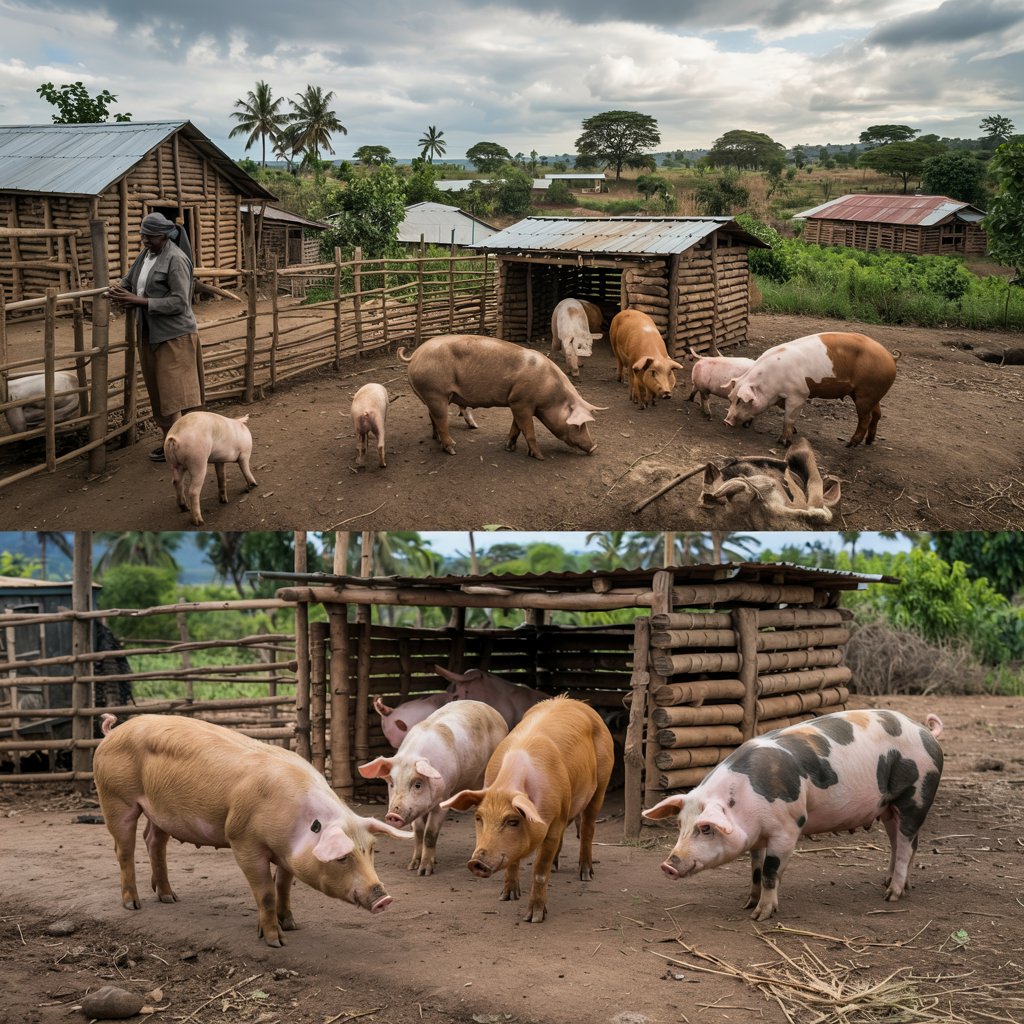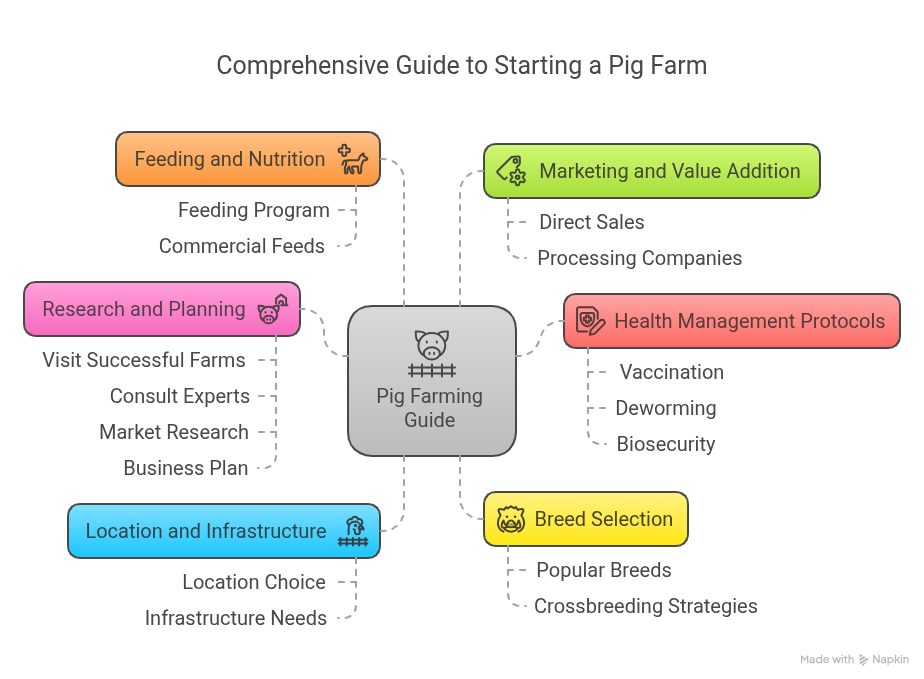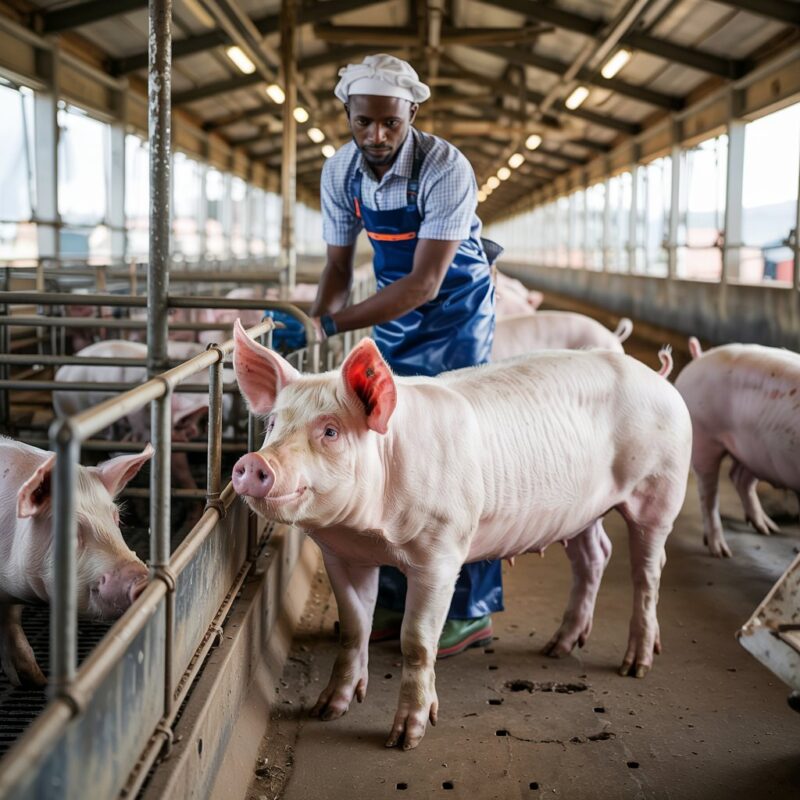The Untapped Gold Mine: Why Pig Farming in Kenya Deserves Your Attention
Let’s cut straight to it — pig farming in Kenya is blowing up right now. With over 1.2 million pigs across the country and production volumes that jumped from 14,400 metric tons in 2019 to a whopping 25,800 metric tons in 2020, this isn’t just a trend — it’s a revolution in Kenyan agriculture.
The numbers don’t lie: Kenyans are consuming about 13kg of pork per person annually, and that figure is expected to double by 2030. Why? Urbanization is changing food preferences, and people are discovering what pig farmers already know — pork is delicious, versatile, and increasingly accessible.
What makes pig farming particularly attractive is the quick turnaround. Unlike cattle that take years to mature, pigs have a shorter production cycle, making them perfect for farmers looking for faster returns. Whether you’re already in the game or thinking about jumping in, the timing couldn’t be better.
The Lay of the Land: Where Pig Farming Thrives in Kenya
Pig farming in Kenya has distinct regional patterns that any smart investor should know about. According to data from the Kenya National Bureau of Statistics, the distribution looks something like this:
| Province | Number of Pigs |
|---|---|
| Central Province | 91,977 |
| Western Province | 87,838 |
| Rift Valley Province | 48,495 |
| Eastern Province | 43,480 |
| Nairobi | 29,976 |
| Nyanza Province | 27,612 |
| Coast Province | 5,243 |
| North Eastern Province | 68 |
Western Province holds the dominant share of pig population at over 40%, showing a long-standing cultural acceptance of pork consumption in these areas. But what’s really interesting is seeing pig farming emerge in regions like North Eastern and Coast provinces, where it was previously non-existent. This suggests evolving acceptance patterns and potential new market opportunities across Kenya.
Two Paths: Commercial vs. Traditional Pig Farming Systems
In Kenya, you’ll find two main production systems, each with its own set of characteristics:
Commercial Farming Systems
These operations account for approximately 149,965 pigs (about 45% of the total population) and are predominantly found in Eastern and Central Provinces, with significant presence in Nairobi outskirts and Coast Province.
Commercial systems typically involve:
- More structured management practices
- Better infrastructure with proper housing
- Higher investment levels
- Dedicated feed regimens
- Scheduled health management protocols
If you’re serious about scaling, this is likely the direction you’ll want to head in. Commercial operations tend to achieve better productivity and can supply more consistent quality to formal markets.
Traditional/Backyard Systems
These systems raise approximately 187,073 pigs (55% of the population) and are concentrated in Western and Nyanza Provinces, with some presence in urban slums of Nairobi.
Traditional systems are characterized by:
- Free-range or semi-intensive methods
- Minimal infrastructure investment
- Reliance on scavenging and household waste for feeding
- Limited health management protocols
For farmers just starting out or those with limited capital, traditional systems offer a lower barrier to entry. However, they come with significant challenges that we’ll get into later.
The Reality on the Ground: Farming Methods and Practices
Free-Range Dominance
The predominant farming method in Kenya, particularly in Western regions, is the free-range system. Research indicates that 69.1% of farmers practice free-range pig rearing, where animals are allowed to scavenge for food with minimal confinement. This practice is especially common during post-harvest periods, with pigs often tethered during planting seasons to prevent crop damage.
Three distinct free-range systems exist in Kenya:
- Urban roaming pigs in informal settlements scavenging on garbage
- Peri-urban free-range pigs near institutional facilities
- Small-scale farmer-owned free-range pigs in Western Kenya and Nyanza, where farmers typically own 2-5 pigs
The reality check? 77.8% of farmers don’t have fenced farms. This lack of proper housing and containment facilities contributes significantly to disease transmission and management challenges.
Feeding: What’s on Your Pig’s Menu?
Feeding practices reflect the split between production systems. In traditional backyard operations, pigs predominantly rely on scavenging, household waste, and agricultural by-products. The data shows that 87% of farmers don’t source feed from outside their farms, indicating heavy reliance on locally available feed resources. Similarly, 92% of farmers utilize water sources within their own farms rather than external sources.
Commercial operations, meanwhile, typically use formulated feeds or a combination of commercial feeds and locally available ingredients. This more balanced nutrition contributes to better growth rates and overall productivity.
Health Management: The Achilles’ Heel
Here’s where many operations fall short: only 29.6% of farmers practice routine deworming and 30.3% implement vaccination programs. This low adoption of preventive health measures contributes to disease susceptibility and reduced productivity across the sector.
The Hard Truth: Challenges Facing Pig Farmers in Kenya
Disease Outbreaks: The Silent Killer
Disease outbreaks represent one of the most significant challenges facing pig farmers in Kenya. African Swine Fever (ASF) poses a particular threat, especially in free-range systems where biosecurity measures are minimal or non-existent. The predominance of traditional production methods increases vulnerability to diseases due to insufficient preventive health protocols.
Porcine cysticercosis (PC) presents a critical concern, particularly in Western Kenya, where it’s propagated by free-range production systems and inconsistent sanitation practices. Despite relatively high latrine ownership among households (87.6%), issues with consistent usage (72.8%) contribute to disease transmission cycles between humans and pigs.
Biosecurity: The Missing Link
Biosecurity implementation remains inadequate across all production systems but is particularly problematic in traditional/backyard operations. External biosecurity (bioexclusion), biocontainment, and biomanagement are critical components that require significant improvement to prevent disease transmission between herds and from wild animals.
Infrastructure and Capital: The Growth Barriers
Inadequate infrastructure severely hampers sector development. Poor housing facilities, limited access to clean water, and substandard slaughter facilities create bottlenecks throughout the value chain. The lack of proper slaughter infrastructure forces some traders and farmers to undertake home slaughter, raising significant food safety concerns.
Limited access to capital for upscaling operations represents another significant barrier reported across the sector. This constraint affects farmers’ ability to invest in better housing, feeding systems, health management protocols, and general farm improvements necessary for productivity enhancement.
Regulatory and Governance Issues: The System Problems
The pig farming sector faces multiple governance-related challenges that impede its development:
- Inadequate enforcement of existing regulations
- Negative effects of the devolution system of governance
- Dominance of pig traders in the value chain
- Lack of farmer associations across system nodes
- Male dominance across the pig system
- Excessive regulation in some aspects while lacking enforcement in others
These governance issues create an environment where compliance with best practices becomes difficult, and power imbalances within the value chain disadvantage primary producers.

From Farm to Fork: Understanding the Pork Value Chain
Market Structure and Meat Inspection
The Kenyan pork value chain encompasses a mix of formal and informal channels. Local independent abattoirs account for 16.4% of pork processing and primarily source from small farmers in neighboring areas (70% of their supply). These small-scale production facilities face numerous operational challenges.
Meat inspection practices raise significant concerns, particularly in Western Kenya. Research conducted in Busia and Kakamega counties revealed that meat inspection is inadequately practiced according to 76.9% of butcher owners and 62.5% of slaughter slab workers. This inadequate inspection creates substantial food safety risks for consumers.
Food Safety Concerns: What You Need to Know
Several critical food safety concerns emerge from the research:
- Inadequate slaughter facilities forcing traders/farmers to undertake home slaughter
- Lack of knowledge regarding disease management
- Insufficient training on hygienic practices in slaughterhouses
- Lack of capital to purchase proper equipment for processing and handling pork
The inadequate inspection of slaughtered pigs leads to potential public health risks, particularly from zoonotic diseases like porcine cysticercosis. Studies recommend implementing effective pig management practices at the farm level and improving pork meat inspection protocols to ensure food safety throughout the value chain.
The Upside: Economic Potential and Opportunities in Pig Farming
Despite the numerous challenges, pig farming in Kenya presents significant economic opportunities. The sector offers lucrative potential for income generation and food security due to several factors:
- Rising domestic demand for pork products
- Shorter production cycle compared to ruminant animals
- Projected doubling of pork consumption by 2030
- Increasing urbanization and evolving dietary preferences
With proper investment in improved breeds, enhanced management practices, effective disease control, and value addition initiatives, the sector has substantial room for growth and development. The expanding geographical reach of pig farming into traditionally non-pig-keeping areas further suggests growing acceptance and market potential across Kenya.
Getting Started: Step-by-Step Guide to Launching Your Pig Farm
Step 1: Research and Planning
Before diving in, take time to:
- Visit successful pig farms in your region
- Consult with agricultural extension officers
- Research market demand and prices in your target area
- Develop a comprehensive business plan with clear objectives
- Calculate startup costs, operational expenses, and projected returns
Step 2: Location and Infrastructure
Choose your location wisely:
- Ensure adequate space based on your planned scale
- Consider proximity to markets and veterinary services
- Check local regulations regarding livestock farming
- Evaluate water availability and quality
Basic infrastructure requirements:
- Well-ventilated housing with concrete flooring
- Separate areas for different growth stages (farrowing, weaning, finishing)
- Secure fencing to prevent escapes and wild animal intrusions
- Feed storage facilities protected from moisture and pests
- Waste management systems
Step 3: Breed Selection
Popular pig breeds in Kenya include:
- Large White: Excellent growth rates and large litter sizes
- Landrace: Known for good mothering abilities
- Duroc: Hardy with good meat quality
- Hampshire: Disease-resistant with good growth traits
- Local breeds: Better adapted to local conditions but slower growth
Consider crossbreeding strategies to combine desirable traits like adaptability, growth rates, and disease resistance.
Step 4: Feeding and Nutrition
Develop a feeding program based on:
- Age and production stage of pigs
- Locally available feed ingredients
- Nutritional requirements (protein, energy, minerals)
Commercial operations should:
- Work with animal nutritionists to formulate balanced rations
- Consider feed efficiency when selecting feed ingredients
- Implement systematic feeding schedules
Small-scale farmers can:
- Supplement scavenging with kitchen waste and agricultural by-products
- Gradually introduce commercial feeds as the operation grows
- Focus on improving feed conversion efficiency
Step 5: Health Management Protocols
Implement preventive health measures:
- Regular vaccination against common diseases
- Routine deworming every 3-4 months
- Strict biosecurity measures to prevent disease introduction
- Regular health monitoring and prompt treatment of sick animals
- Maintain health records for each animal
Step 6: Marketing and Value Addition
Explore multiple marketing channels:
- Direct sales to butcheries and restaurants
- Supply to processing companies
- Participation in farmer groups for collective marketing
- Value addition through simple processing (e.g., smoked products)

Scaling Up: How to Grow Your Pig Farming Business
Vertical Integration Opportunities
Consider moving beyond primary production by:
- Establishing a small slaughter facility with proper certification
- Developing processed pork products like sausages and bacon
- Creating your own brand of pork products
- Setting up a small retail outlet for direct consumer sales
Technology Adoption for Improved Efficiency
Embrace technologies that enhance productivity:
- Record-keeping software for tracking performance metrics
- Automated feeding systems to reduce labor and feed wastage
- Water filtration and recycling systems
- Biogas production from pig waste
- Online marketing platforms to reach wider customer base
Financing and Business Development
Access growth capital through:
- Agricultural loans from banks and microfinance institutions
- Government subsidies and support programs
- Partnership with investors
- Reinvestment of profits into business expansion
The Future of Pig Farming in Kenya: Trends and Projections
Market Growth and Consumer Preferences
The future looks promising with:
- Projected doubling of pork consumption by 2030
- Growing middle class with increasing meat consumption
- Evolving culinary scene incorporating more pork dishes
- Expansion of supermarket chains creating demand for quality pork products
Sustainability and Environmental Considerations
Forward-thinking farmers are focusing on:
- Waste-to-resource conversion through biogas and fertilizer production
- Reducing environmental impact through improved waste management
- Integration of pig farming with crop production for circular systems
- Climate-smart pig farming practices
The Takeaway: Is Pig Farming Right for You?
Pig farming in Kenya presents a sector with substantial untapped potential that requires strategic interventions to overcome its current challenges. The stark contrast between traditional backyard systems prevalent in Western Kenya and more commercial operations in Central and Eastern regions necessitates tailored approaches to sector development.
For newcomers to the industry, starting small with good management practices and gradually scaling up makes the most sense. Focus on these key areas:
- Enhance biosecurity measures, particularly if using free-range systems
- Improve access to capital through cooperative groups or agricultural loans
- Invest in proper housing and feeding systems from the start
- Implement rigorous health management protocols
- Explore value addition opportunities to capture greater market share
With strategic approaches, pig farming in Kenya can overcome its current limitations and realize its full potential as a significant contributor to food security, income generation, and agricultural diversification in the coming years. The projected doubling of pork consumption by 2030 presents a substantial opportunity for sector growth if the fundamental challenges can be effectively addressed through coordinated stakeholder efforts.
Ready to take the plunge into this growing industry? Start with research, plan carefully, and connect with experienced farmers in your area. The journey to successful pig farming begins with a single step — and now you have the roadmap to guide you.










